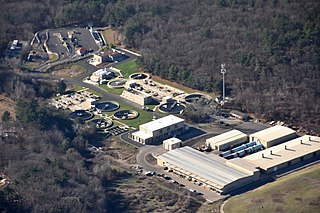 W
WSewage treatment is the process of removing contaminants from municipal wastewater, containing mainly household sewage plus some industrial wastewater. Physical, chemical, and biological processes are used to remove contaminants and produce treated wastewater that is safe enough for release into the environment. A by-product of sewage treatment is a semi-solid waste or slurry, called sewage sludge. The sludge has to undergo further treatment before being suitable for disposal or application to land.
 W
WA combined sewer is a sewage collection system of pipes and tunnels designed to simultaneously collect surface runoff and sewage water in a shared system. This type of gravity sewer design is no longer used in almost any instance worldwide when constructing new sewer systems. Modern-day sewer designs exclude surface runoff from sanitary sewers, but many older cities and towns continue to operate previously constructed combined sewer systems.
 W
WA constructed wetland (CW) is an artificial wetland to treat municipal or industrial wastewater, greywater or stormwater runoff. It may also be designed for land reclamation after mining, or as a mitigation step for natural areas lost to land development.
 W
WEffluent sewer systems, also called septic tank effluent drainage (STED) or solids-free sewer (SFS) systems, have septic tanks that collect sewage from residences and businesses, and the effluent that comes out of the tank is sent to either a centralized sewage treatment plant or a distributed treatment system for further treatment. Most of the solids are removed by the septic tanks, so the treatment plant can be much smaller than a typical plant. In addition, because of the vast reduction in solid waste, a pumping system can be used to move the wastewater rather than a gravity system.
 W
WEsholt Sewage Works Railway was a standard gauge works railway constructed in 1910 to serve a sewage works in Esholt, West Yorkshire, England.
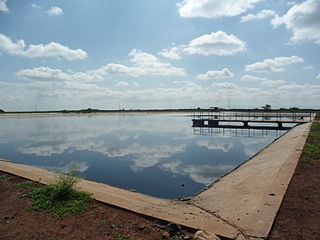 W
WFacultative lagoons are a type of waste stabilization pond used for biological treatment of industrial and domestic wastewater. Sewage or organic waste from food or fiber processing may be catabolized in a system of constructed ponds where adequate space is available to provide an average waste retention time exceeding a month. A series of ponds prevents mixing of untreated waste with treated wastewater and allows better control of waste residence time for uniform treatment efficiency.
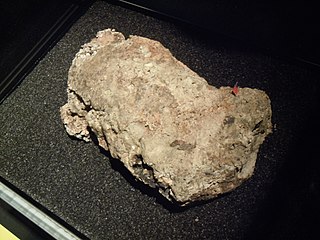 W
WA fatberg is a rock-like mass of waste matter in a sewer system formed by the combination of flushed non-biodegradable solids, such as wet wipes, and congealed grease or cooking fat. Fatbergs have occurred in cities and towns worldwide, with the rise in usage of disposable cloths. Several prominent examples were discovered in the 2010s in Great Britain, their formation accelerated by ageing Victorian sewers. Fatbergs are costly to remove, and have given rise to public awareness campaigns about flushable waste.
 W
WA gravity sewer is a conduit utilizing the energy resulting from a difference in elevation to remove unwanted water. The term sewer implies removal of sewage or surface runoff rather than water intended for use; and the term gravity excludes water movement induced through force mains or vacuum sewers. Most sewers are gravity sewers; because gravity offers reliable water movement with no energy costs wherever grades are favorable. Gravity sewers may drain to sumps where pumping is required to either force sewage to a distant location or lift sewage to a higher elevation for entry into another gravity sewer, and lift stations are often required to lift sewage into sewage treatment plants.
 W
WA grease trap is a plumbing device designed to intercept most greases and solids before they enter a wastewater disposal system. Common wastewater contains small amounts of oils which enter into septic tanks and treatment facilities to form a floating scum layer. This scum layer is very slowly digested and broken down by microorganisms in the anaerobic digestion process. Large amounts of oil from food preparation in restaurants can overwhelm a septic tank or treatment facility, causing release of untreated sewage into the environment. High-viscosity fats and cooking grease such as lard solidify when cooled, and can combine with other disposed solids to block drain pipes.
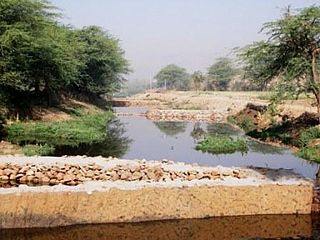 W
WGreen bridges are an ecotechnological in-situ bio remediation system. Their different physical and biological filters work in combination to remove suspended and dissolved impurities of water. Green bridge filters help in reducing the suspended solids by filtration process, reducing Chemical Oxygen Demand (COD)/Biochemical Oxygen Demand (BOD) by aerobic degradation. Green Bridges also help in the restoration of ecological food chain.
 W
WA dump station is a place where raw sewage may be entered into a sanitary sewer system in a safe and responsible way. Dump stations are often used by owners of motorhomes, campervans, recreational vehicles or boats that are equipped with toilet facilities and a sewage holding tank, also known as a blackwater holding tank. The holding tank can be safely emptied at a dump station. Greywater holding tanks can also be emptied at a dump station.
 W
WThe Imhoff tank, named for German engineer Karl Imhoff (1876–1965), is a chamber suitable for the reception and processing of sewage. It may be used for the clarification of sewage by simple settling and sedimentation, along with anaerobic digestion of the extracted sludge. It consists of an upper chamber in which sedimentation takes place, from which collected solids slide down inclined bottom slopes to an entrance into a lower chamber in which the sludge is collected and digested. The two chambers are otherwise unconnected, with the more liquid sewage flowing only through the upper sedimentation chamber and only a slow flow of sludge in the lower digestion chamber. The lower chamber requires separate biogas vents and pipes for the removal of digested sludge, typically after 6-9 months of digestion. The Imhoff tank is in effect a two-story septic tank and retains the septic tank's simplicity while eliminating many of its drawbacks, which largely result from the mixing of fresh sewage and septic sludge in the same chamber.
 W
WJames Newlands was a Scottish civil engineer who worked in Liverpool as the first Borough Engineer appointed in the United Kingdom, and is credited with designing and implementing the first integrated sewerage system in the world in 1848.
 W
WThe sewers of the French capital Paris date back to the year 1370 when the first underground system was constructed under Rue Montmartre. Consecutive French governments enlarged the system to cover the city's population, including expansions under Louis XIV and Napoleon III, and modernisation programs in the 1990s under Mayor Jacques Chirac. The system has featured in popular culture through its existence, including Victor Hugo's 1862 novel, Les Misérables, and H. L. Humes' 1958 novel The Underground City.
 W
WThe Petersham Hole was a sink hole caused by subsidence of a sewer which forced the total closure of the A307 road in Petersham in the London Borough of Richmond upon Thames in 1979–80.
 W
WA combined sewer is a sewage collection system of pipes and tunnels designed to simultaneously collect surface runoff and sewage water in a shared system. This type of gravity sewer design is no longer used in almost any instance worldwide when constructing new sewer systems. Modern-day sewer designs exclude surface runoff from sanitary sewers, but many older cities and towns continue to operate previously constructed combined sewer systems.
 W
WA sanitary sewer or foul sewer is an underground pipe or tunnel system for transporting sewage from houses and commercial buildings to treatment facilities or disposal. Sanitary sewers are part of an overall system called a sewage system or sewerage.
 W
WSecondary treatment is a treatment process for wastewater to achieve a certain degree of effluent quality by using a sewage treatment plant with physical phase separation to remove settleable solids and a biological process to remove dissolved and suspended organic compounds. After this kind of treatment, the wastewater may be called as secondary-treated wastewater.
Septic drain fields, also called leach fields or leach drains, are subsurface wastewater disposal facilities used to remove contaminants and impurities from the liquid that emerges after anaerobic digestion in a septic tank. Organic materials in the liquid are catabolized by a microbial ecosystem.
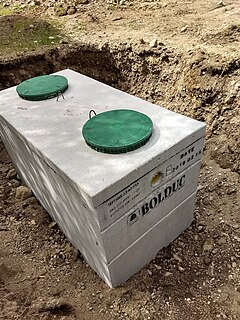 W
WA septic tank is an underground chamber made of concrete, fiberglass, or plastic through which domestic wastewater (sewage) flows for basic treatment. Settling and anaerobic processes reduce solids and organics, but the treatment efficiency is only moderate. Septic tank systems are a type of simple onsite sewage facility (OSSF). They can be used in areas that are not connected to a sewerage system, such as rural areas. The treated liquid effluent is commonly disposed in a septic drain field, which provides further treatment. Nonetheless, groundwater pollution may occur and can be a problem.
 W
WSewage farms use sewage for irrigation and fertilizing agricultural land. The practice is common in warm, arid climates where irrigation is valuable while sources of fresh water are scarce. Suspended solids may be converted to humus by microbes and bacteria in order to supply nitrogen, phosphorus and other plant nutrients for crop growth.
 W
WSewage treatment is the process of removing contaminants from municipal wastewater, containing mainly household sewage plus some industrial wastewater. Physical, chemical, and biological processes are used to remove contaminants and produce treated wastewater that is safe enough for release into the environment. A by-product of sewage treatment is a semi-solid waste or slurry, called sewage sludge. The sludge has to undergo further treatment before being suitable for disposal or application to land.
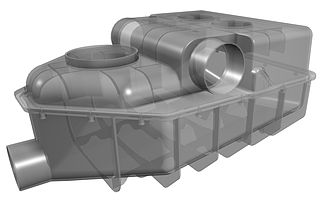 W
WA sewer dosing unit (SDU) is a plumbing device to allow effective sewage disposal with low liquid-flow rates. With a global emphasis on water saving, many new buildings and renovations are seeing the installation of water saving fixtures such as low flow shower heads and low flush toilets. With the decrease in wastewater flows problems are arising from waste solids not being carried completely to the main sewers, often causing blockages.
 W
WA vacuum sewer or pneumatic sewer system is a method of transporting sewage from its source to a sewage treatment plant. It maintains a partial vacuum, with an air pressure below atmospheric pressure inside the pipe network and vacuum station collection vessel. Valves open and reseal automatically when the system is used, so differential pressure can be maintained without expending much energy pumping. A single central vacuum station can collect the wastewater of several thousand individual homes, depending on terrain and the local situation.
 W
WA vacuum truck or vacuum tanker is a tank truck that has a pump and a tank. The pump is designed to pneumatically suck liquids, sludges, slurries, or the like from a location into the tank of the truck. The objective is to enable transport of the liquid material via road to another location. Vacuum trucks transport the collected material to a treatment or disposal site, for example a sewage treatment plant.
 W
WWaste stabilization ponds are ponds designed and built for wastewater treatment to reduce the organic content and remove pathogens from wastewater. They are man-made depressions confined by earthen structures. Wastewater or "influent" enters on one side of the waste stabilization pond and exits on the other side as "effluent", after spending several days in the pond, during which treatment processes take place.